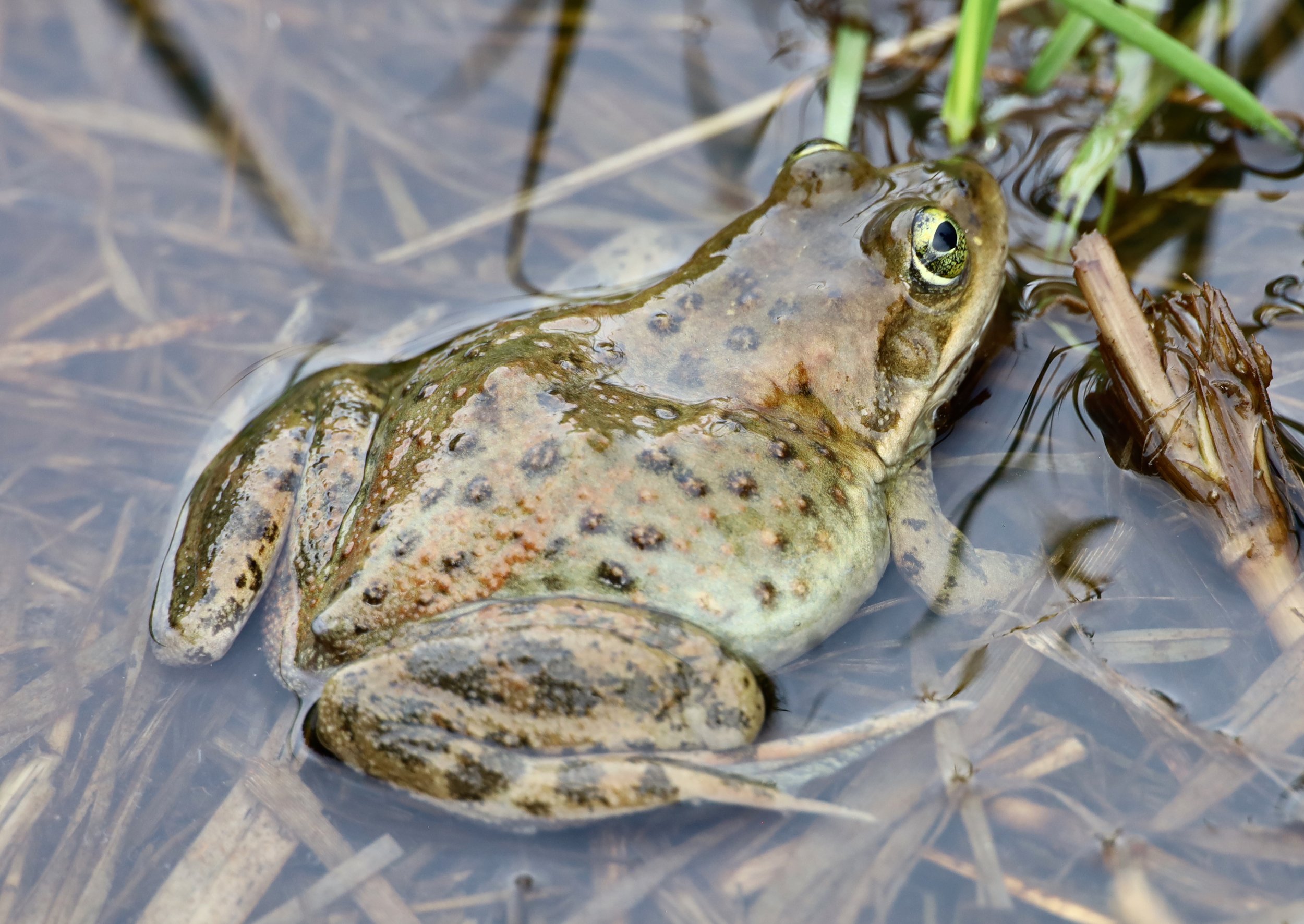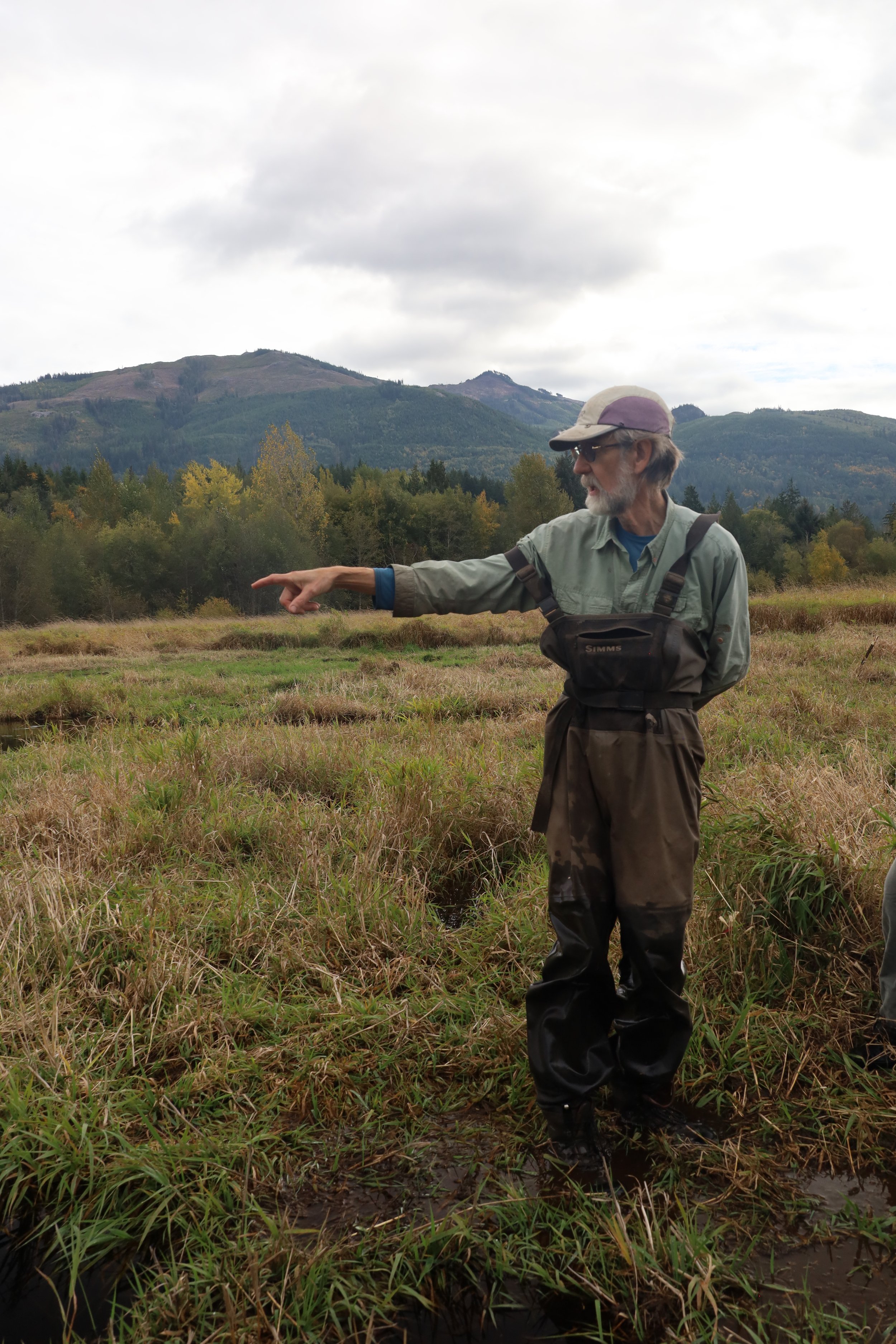Hoping for a Hopping Success
The issues facing Oregon spotted frogs are leading local scientists' efforts to conserve and protect the endangered species in Skagit and Whatcom County
An Oregon Spotted Frog peers above the waterline. She watches for prey while keeping an eye out for predators. // Photo by Reid Hunter
Story by Ivy Lonczak | Photos by Reid Hunter
December 7, 2023
It's warmer than expected this time of year in Whatcom County, Washington. Stephen Nyman, a seasoned amphibian expert and lead scientist for The Whatcom County Amphibian Monitoring Program (WCAMP), explains that this unusually warm October weather will allow us to see frogs when they would normally be dormant.
We met at the WCAMP Oregon spotted frog restoration site, next to the Samish River. The site is located on an old agricultural field that is crowded with tall grasses and surrounded by mountainscapes. Nyman walks down a hand-cut pathway in the tall grass, pointing out the bunches of invasive reed canary grass. As we walk, the soles of our boots become caked in the mucky substrate.The path is made of decomposing reed grass, which often falls over into the water and continues to grow from its stem. This covers and shrinks the frogs’ primarily aquatic habitat and crucial breeding grounds.
Wetland protected by the Whatcom County Amphibian Monitoring Program and home to endangered Oregon Spotted Frogs. Nyman and the WCAMP team have devoted much time to protecting and maintaining this sanctuary for the frogs. // Photo by Reid Hunter
We quickly come across a chunky female frog, who has seemingly been waiting for us. She seems to be trying to bask in the sun, but there is only a glimpse of gray light peeking through the clouds. Her glowing chartreuse eyes glint in the light and stand out against the sunken plant sludge around her. Her skin is olive, with dark brown and orange spots scattered across her back and legs.
She is a lighter color than most frogs this time of year, Nyman explains. The frog's skin often gets darker during cooler fall months.
Nyman can sometimes tell which frog is in which pool using their specific skin patterns and the shape of their lip-lines to tell them apart. He searches for a frog called “eight”, who has an unusual, sideways figure-eight-shaped marking.
Identifying which pools the frogs prefer helps him to see when a rehabilitated habitat is successful and ideal for breeding. He measures success by the number of frogs that make it to adulthood from their eggs.
The female frog, called “eight, " has an unusual, sideways figure-eight-shaped marking on her back // Photo by Stephen Nyman
The progress made at the WCAMP restoration site has been encouraging. In 2023, 93 egg masses (which can contain up to 1,500 eggs) were found on the site as compared to 80 egg masses the year before. However, the work to increase Oregon spotted frog populations is far from over. Despite conservation efforts, their population is still in decline.
In fact, amphibian species around the world have been dying at alarming rates.
Two hundred frog species have been lost already, and hundreds more are expected to become extinct over the next century, according to a study published in the Proceedings of the National Academy of Sciences. The global loss of amphibians affects the food chain, as frogs serve as both a predator and prey species.
“Frogs are very sensitive to temperature, chemicals, water quality and so many things that are out there,” Gregory Green, a wildlife ecologist at Western Washington University, said. “When those factors start to degrade you quickly see a decline in the frogs. Kind of like a canary in a coal mine.”
Stephen Nyman, a local scientist and amphibian expert, gestures to one of the pools in the wetland, pointing to the iridescent biofilm on the water caused by bacteria from decaying plants //Photo by Reid Hunter
The global decline of frogs, and just how quickly humans have impacted these ancient species, all serve as a warning sign.
“They are a bellwether for climate change,” Green said.
Oregon spotted frogs have lost about 80% of their habitat and are projected to lose even more, according to the Washington Department of Fish and Wildlife. Climate change, and its effects on temperatures, have begun to dry up the shallow pools and marshes Oregon spotted frogs rely on for habitat as tadpoles. Wetland alteration, the introduction of native species, and drought are also factors to blame.
The declining population of Oregon spotted frogs is worrisome for local communities. Frogs are culturally significant to the Coast Salish peoples and have appeared in many stories, teachings and carvings over time. Frogs are represented in the Samish calendar, which marks seasonal change and follows the cycles of the moon.
“‘Wexes’ or ‘Moon of the Frog’ is mid-Feb to mid-March. When the frogs are heard, we know that winter is coming to a close and spring is on the horizon,” Jodi Blume, Natural Resources Senior Director for the Samish Nation, said in an email.
Oregon spotted frogs are different from most of the Pacific Northwest's amphibians because they are predominantly aquatic. Breeding requires warmer, open areas of shallow water, with short grass and no tall trees. They breed in the same location every year, so when a breeding spot is destroyed, it can be enough to wipe out an entire colony of frogs.
A chunky, olive-colored female frog, with orange and brown speckles. She sits on piles of reed canary grass. // Photo by Reid Hunter
Farmlands that contain livestock have often been modified partially in the frogs’ favor. The livestock eat the grass and keep it short, providing ideal frog conditions. However, conservationists who are concerned about water quality often pull livestock away from the water and plant trees instead. This causes the habitat to become unsuitable for the Oregon spotted frog.
“It's kind of an issue of us trying to improve habitats for other species such as salmon and other amphibians, which will benefit from that. And this particular weird little frog doesn’t want that,” Vikki-Lyn Jackson, project manager for WCAMP, said.
Oregon spotted frogs are affected by a variety of invasive species, such as reed canary grass, bullfrogs and other introduced fish species.
These invasive species are taking a toll on other native animals. Vegetation is taken over by reed canary grass, leaving animals with little food and habitat. Bullfrogs do the same, according to Blume.
Stephen Nyman explains the details of the ecosystem and the habitats of the frogs. He points to bunches of invasive reed canarygrass, which he plans to remove. // Photo by Reid Hunter
American bullfrogs are a huge threat to Washington state wildlife. They are triple the size of the Oregon spotted frog and can eat them whole. This is very alarming for scientists like Nyman, who urge private landowners to identify and help reduce this invasive species.
“We’re just being vigilant. I think the best thing that could be done, would be if there was an effort to reduce them in places where they are right now,” Nyman said.
Bullfrogs can often become carriers of the deadly disease Chytrid Fungus. It also lingers in fresh bodies of water and can be spread by thirsty livestock. According to the Center for Invasive Species Research, the fungus is a skin disease that eventually leads to heart attack and death. This disease has contributed to the decline of over 50% of the world's frog species.
Climate change has allowed bullfrogs, and this disease, to spread farther north.
“When a plant they [Coast Salish people] have used for time immemorial is no longer easy to find or the sounds of the frogs for instance have changed, it affects them on a deep level and they feel very saddened by it,” Blume said in an email.
So far, according to Jackson, the Oregon spotted frogs at the WCAMP restoration site have not shown signs of carrying Chytrid Fungus. However, the disease has been detected in most Oregon spotted frog populations in Washington, according to Nyman. The WCAMP team is taking precautions, but the spread may be inevitable.
For more information and local volunteer opportunities regarding Oregon spotted frogs, visit the WCAMP website.
An Oregon Spotted Frog swims across a shallow pool. The pool has bits and pieces of decomposing reed canary grass floating in it. // Photo by Reid Hunter
Pick up a copy of Klipsun Magazine’s Winter 2023 edition to read more about the Oregon spotted frog in Meghan Fenwick’s story, ‘Endangered Frog Finds Solace in Whatcom County.’
Ivy Lonczak is an environmental studies student who loves animals and is passionate about environmental issues.
Reid Hunter is a sophomore at Western with a passion for portraying the fragile beauty and importance of nature through his photography







